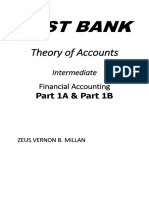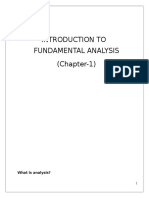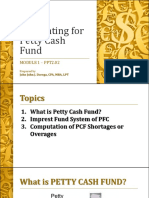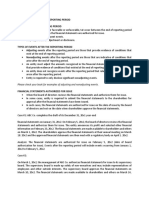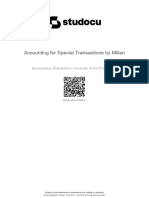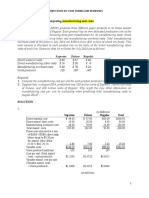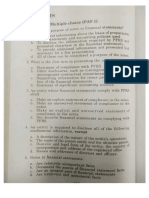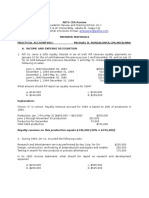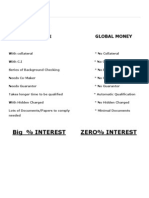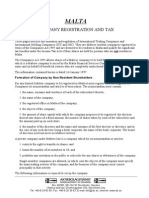Test Bank Theory of Accounts Preview
Test Bank Theory of Accounts Preview
Uploaded by
Marjorie PalmaCopyright:
Available Formats
Test Bank Theory of Accounts Preview
Test Bank Theory of Accounts Preview
Uploaded by
Marjorie PalmaCopyright
Available Formats
Share this document
Did you find this document useful?
Is this content inappropriate?
Copyright:
Available Formats
Test Bank Theory of Accounts Preview
Test Bank Theory of Accounts Preview
Uploaded by
Marjorie PalmaCopyright:
Available Formats
lOMoARcPSD|9332576
TEST BANK Theory OF Accounts Preview
Theory of Accounts Integration 2 (Cordillera Career Development College)
StuDocu is not sponsored or endorsed by any college or university
Downloaded by Goodwin Dallas (dallasgoodwin899@gmail.com)
lOMoARcPSD|9332576
TEST
BANK
Theory of
Accounts
Intermediate
Financial Accounting
Part 1A & Part 1B
Downloaded by Goodwin Dallas (dallasgoodwin899@gmail.com)
lOMoARcPSD|9332576
ZEUS VERNON B. MILLAN
Chapter 1
Overview of Accounting
Chapter 1: Theory of Accounts Reviewer
Definition of Accounting
1. Accounting has been given various definitions, which of the following is
not one of those definitions
a. Accounting is a service activity. Its function is to provide quantitative
information, primarily financial in nature, about economic entities that
is intended to be useful in making economic decisions.
b. Accounting is the art of recording, classifying, and summarizing in a
significant manner and in terms of money, transactions and events
which are, in part of at least, of a financial character and interpreting
the results thereof.
c. Accounting is a systematic process of objectively obtaining and
evaluating evidence regarding assertions about economic actions and
events to ascertain the degree of correspondence between these
assertions and established criteria and communicating the results to
interested users.
d. Accounting is the process of identifying, measuring, and
communicating economic information to permit informed judgment
and decisions by users of information.
Downloaded by Goodwin Dallas (dallasgoodwin899@gmail.com)
lOMoARcPSD|9332576
2. It is the first process used in accounting. It refers to the identification of
events as to whether they are recognized or not in the financial
statements.
a. Identifying b. Measuring c. Communicating d. Auditing
3. The following statements correctly refer to the accounting process.
I. Measuring is the accounting process of analyzing business activities as
to whether or not they will be recognized in the books.
II. Recognition refers to the process of including the effects of an event in
the totals of the statement of financial position or the statement of
profit or loss and other comprehensive income through memo entries.
III. Disclosure of events in the notes to financial statement without
including in the totals of the statement of financial position or
statement of profit or loss and other comprehensive income is not an
application of the recognition principle.
IV. An accountable event is an event that has an effect on the assets,
liabilities or equity of an entity and its effect can be measured reliably.
V. Sociological and psychological matters are within the scope of
accounting.
a. I, II, III, IV, V b. I, II, III, IV c. IV d. III, IV
Types of Events
4. These events involve changes in the economic resources or obligations of
entities involving other entities but do not involve transfers of resources
or obligations
a. External events c. External events other than transfers
b. Non-reciprocal transfers d. Internal events
5. Events involving an entity and an external party.
a. External events c. External events other than transfers
b. Non-reciprocal transfers d. Internal events
6. Events in which an entity transfers (or receives) economic resources to
(from) another entity without directly receiving (or giving) value in
exchange.
a. External events c. External events other than transfers
b. Non-reciprocal transfers d. Internal events
7. These events result to a sudden or unanticipated loss from fortuitous
events.
a. Internal events c. External events other than transfers
b. Non-reciprocal transfers d. Casualty
8. Which of the following statements is true?
I. Loss from theft should be classified as a nonreciprocal transfer
Downloaded by Goodwin Dallas (dallasgoodwin899@gmail.com)
lOMoARcPSD|9332576
II. Internal events are changes in economic resources by actions of other
entities that do not involve transfers of enterprise resources and
obligations
III. Nonreciprocal transfers involve the transfer of resources in only one
direction, either from an entity to other entities or from other entities
to the entity.
IV. Internal events are sudden, substantial, unanticipated reductions in
enterprise resources not caused by other entities
V. Fire, earthquake and flood are examples of accountable events
classified as internal events.
a. I, II, III, V b. I, III, V c. II, III, IV, V d. I, III, IV, V
9. All of the following are events considered as exchange or reciprocal
transfer, except
a. purchase of investment in equity securities
b. sale of equipment for non-interest bearing note
c. subscription on the entity’s own equity instrument
d. exchange of a note payable for an account payable
e. borrowing of money from a bank
10. All of the following are events considered as nonreciprocal transfer,
except
a. declaration of cash dividends c. payment of accounts payable
b. declaration of stock dividends d. imposition of fines
11. All of the following are events considered as external events other than
transfers, except
a. obsolescence c. imposition of fines
b. inflation d. vandalism
12. All of the following are events considered as internal events, except
a. Transfer of goods from work-in-process to finished goods inventory
b. flood, earthquake, fire and other “Acts of God”
c. transformation of biological assets from immature to mature
d. vandalism committed by the entity’s employees
13. Which of the following events is considered an internal event?
a. sale of inventory on account
b. provision of capital by owners
c. borrowing of money
d. conversion of raw materials into finished goods
14. Which of the following events is considered an external event?
a. production c. payment of taxes
b. casualty loss d. growth of biological assets
Downloaded by Goodwin Dallas (dallasgoodwin899@gmail.com)
lOMoARcPSD|9332576
15. Which of the following events is considered an internal event?
a. theft c. vandalism
b. contributions by owners d. degeneration of biological assets
16. Which of the following correctly relates to accountable events?
I. An obsolete asset which has no use was received in exchange of an
existing asset. This transaction may be classified as an exchange.
II. An entity exchanges a non-cash asset for another non-cash asset in an
exchange transaction with commercial substance. This is a reciprocal
transfer.
III. An entity issues its shares of stocks in exchange for a non-cash asset.
This is a reciprocal transfer.
a. I b. II c. II, III d. I, II, III
17. An example of income derived from a nonreciprocal transfer is
a. compensation received as damages in a successful lawsuit
b. appreciation of property
c. land acquired from a stockholder as donation
d. settlement of a liability at less than its book value
(RPCPA)
Measuring
18. Asset measurements in conventional financial statements
a. are confined to historical cost
b. are confined to historical cost and current cost
c. reflect several financial attributes
d. do not reflect output values
(RPCPA)
19. Financial statements are said to be a mixture of fact and opinion.
Which of the following items is factual?
a. cost of goods sold c. discount on capital stock
b. retained earnings d. patent amortization expense
(Adapted)
20. On December 31, 200A, Annod Co. decided to end its operations and
dispose its assets within three months. At December 31, 200A, the
carrying amount of an investment property was less than both its fair
value and net realizable value. The fair value is greater than the net
realizable value. What is the appropriate measurement basis for the
investment property in Annod’s December 31, 200A statement of financial
position?
a. Historical cost c. Net realizable value
b. Fair value d. Current replacement cost
Communicating
Downloaded by Goodwin Dallas (dallasgoodwin899@gmail.com)
lOMoARcPSD|9332576
21. These are the principal means through which an entity communicates
its financial information to those outside it.
a. managerial reports c. segment reports
b. financial statements d. directors’ statements
22. The analytical phase of accounting which significantly portrays the
liquidity, solvency, profitability of a business
a. interpreting c. summarizing
b. recording d. classification
(RPCPA)
Basic purpose
23. The basic purpose of accounting is
a. to provide information useful in making economic decisions
b. to provide information useful only for investors
c. to provide information regarding the economic resources controlled by
an entity
d. to provide business owners, politicians, and other government officials
an opportunity to evade taxes
24. One objective of financial reporting is to provide information useful in
assessing the amounts, timing, and uncertainty of future cash flows. In
regards to this objective, which of the following is (are) correct?
I. The emphasis on “assessing cash flow prospects” means that the cash
basis is preferred over the accrual basis of accounting.
II. Information based on accrual accounting generally better indicates an
entity’s present and continuing ability to generate favorable cash flows
than does information limited to the financial effects of cash receipts
and payments.
a. I only b. II only c. I and II d. neither I nor II
25. The primary objective of financial reporting is to provide information:
a. About a firm's financing and investing activities
b. About a firm's economic resources and obligations
c. About a firm's products and services
d. Useful in predicting cash flows
(Adapted)
26. Financial accounting applies to which of the following:
a. Businesses c. Governments
b. Non-profit organizations d. All of these
(Adapted)
27. Stewardship reporting focuses on:
a. Showing investors what sales revenues were
Downloaded by Goodwin Dallas (dallasgoodwin899@gmail.com)
lOMoARcPSD|9332576
b. Showing the financial statement reader just how the resources
entrusted to the management's care were managed
c. Showing employees how high their raises will be
d. Showing the financial statement reader how many shop stewards are
employed
(AICPA)
28. The function of measuring and reporting information to absentee
investors is called the:
a. Accounting function c. Auditing function
b. Stewardship function d. Management function
(AICPA)
29. The following relate to financial reporting. Choose the correct
statement(s).
I. Since financial statements are historical, they are of little use in
making decisions about the future.
II. Financial accounting is based on the presumption that all statement
users need the same information.
III. Financial accounting is expressly designed to measure directly the
value of a business enterprise.
a. I, III b. II, III c. II only d. None
(RPCPA)
30. Financial reporting should provide all of the following information,
except
a. Information that is useful to present and potential investors and
creditors and other users in making rational investment, credit, and
similar decisions.
b. Information that helps present and potential investors, creditors, and
other users assess the amounts, timing, and uncertainty of prospective
cash receipts from dividends or interest and the proceeds from the
sale, redemption, or maturity of securities or loans.
c. Information that is comprehensible only to accountants and auditors
who have reasonable understanding of business and economic
activities and are willing to study the information with reasonable
diligence.
d. Information that clearly portrays the economic resources of an
enterprise, the claims to those resources and the effects of
transactions, events, and circumstances that change its resources and
claims to those resources.
31. Apart from the monetary impact, factors of decision making include:
a. personal taste c. environmental factors
b. social factors d. all of these
(Adapted)
Downloaded by Goodwin Dallas (dallasgoodwin899@gmail.com)
lOMoARcPSD|9332576
32. For the purpose of decision making:
a. accounting information provides information about future events
b. accounting information provides information about the outcomes of
past decisions
c. the future is used as a guide to past estimates
d. the accountant never becomes involved in the budgeting process.
(Adapted)
Economic entities and activities
33. A business that operates to support a cause or interest is known as a
a. not-for-profit organization c. career goal
b. sports franchise d. private entity
34. The most common form of business organization is a
a. corporation c. sole proprietorship
b. partnership d. cell phone stand
(Adapted)
35. Which of the following statements are correct?
I. The economic activities of a business enterprise increase or decrease
its assets and liabilities but never its equity.
II. An internal event involves a transfer or exchange between two or more
entities.
III. Exchange is an economic activity which involves trading resources and
obligations for other resources or obligations.
IV. Income recognition is a basic economic activity which involves the
process of allocating rights to the use of outputs among individuals and
groups in society.
V. An event generally is the source or cause of changes in assets,
liabilities, and equity.
VI. Investment is the process of using current inputs to increase the stock
of resources available for future output as opposed to immediately
consumable output.
a. III, IV, V b. I, II, III, V, VI c. III, V, VI d. II, III, VI
(RPCPA)
36. Which of the following statements correctly refer to the basic economic
activities?
I. Production is the process of converting economic resources into
outputs of goods and services that are intended to have greater utility
than the required inputs.
II. Exchange is the process of trading resources or obligations for other
resources or obligations.
III. Consumption is the process of allocating rights to the use of output
among individuals and groups in society.
Downloaded by Goodwin Dallas (dallasgoodwin899@gmail.com)
lOMoARcPSD|9332576
IV. Income distribution is the process of using the final output of the
production process.
V. Savings is the process of using current inputs to increase the stock of
resources available for output as opposed to immediately consumable
output.
VI. Investment is the process by which individuals and groups set aside
rights to present consumption in exchange for rights to future
consumption.
a. I, II c. I, II, V, VI
b. I, II, III, IV d. I, II, III, IV, V, VI
(RPCPA)
37. Whether a business is successful and thrives is determined by
a. markets. b. free enterprise. c. competition d. all of these
(AICPA)
38. An effective capital allocation process
a. promotes productivity.
b. encourages innovation.
c. provides an efficient market for buying and selling securities.
d. all of these.
(AICPA)
39. A business that operates to earn money for its owners is called a(n)
a. economic entity c. professional organization
b. for-profit business d. owner financed business
(Adapted)
40. A free enterprise system allows businesses to
a. have their government choose their products
b. produce the goods and services they choose
c. buy goods at a discount
d. operate at a profit
(Adapted)
41. One of the disadvantages of a sole proprietorship is
a. all the profits go to the owner c. the owner has all the risks
b. there are no lunch breaks d. there are few regulations to
follow
(Adapted)
42. A corporation is a business organization that is recognized by law to
a. pay no tax c. have an active social life
b. have a life of its own d. have at least 3 owners
(Adapted)
Downloaded by Goodwin Dallas (dallasgoodwin899@gmail.com)
lOMoARcPSD|9332576
43. Those who transform ideas for products or services into real-world
businesses are known as
a. profit takers b. accountants c. entrepreneurs d. organizers
(Adapted)
44. A business owned by two or more people is called
a. a corporation c. a partnership
b. looking for trouble d. venture capital
(Adapted)
45. A merchandising business
a. buys raw materials and transforms them into finished products
b.
c. buys finished products and resells them
d. provides a service for a fee
all of the above
(Adapted)
46. Economic resources are the scarce means available for carrying on
economic activities. The economic resources of a business enterprises
are:
a. productive resources b. products c. money d. all of these
(RPCPA)
47. Which of the following is not among the economic resources of a
business enterprise?
a. money
b. products or output of the enterprise
c. obligations to pay money
d. ownership interest in other enterprises
(RPCPA)
48. It does not truly describe “economic value” as an element of economic
resources
a. value in exchange c. utility
b. over supply of resources d. scarcity
(RPCPA)
Accounting information
49. Which of the following statements is correct?
I. Accounting provides qualitative information, financial information, and
quantitative information.
II. Qualitative information is found in the notes to the financial statements
only.
III. Accounting is considered an art because it is supported by an
organized body of knowledge
Downloaded by Goodwin Dallas (dallasgoodwin899@gmail.com)
lOMoARcPSD|9332576
IV. Accounting is considered a science because it involves the exercise of
skill and judgment.
V. Measurement is the process of assigning numbers to objects such
inventories or plant assets and to events such as purchases or sales.
VI. All quantitative information are also financial in nature.
VII. The accounting process of assigning peso amounts or numbers to
relevant objects and events is known as Identification.
a. I, V b. I, II, VI, V c. I, II, III, IV, V d. II, VI, V
(RPCPA)
50. Which of the following statements is incorrect?
I. The information contained in the financial statements is obtained
exclusively from the firm’s accounting records.
II. Financial accounting is a science rather than an art while management
accounting is an art rather than a science.
III. Management decisions are oriented to the future whereas the
decisions of external users are oriented to the past.
IV. Financial accounting is a branch of accounting which deals primarily
with the common needs of users while management accounting is a
branch of accounting which deals primarily with the specific needs of
users.
V. Quantitative information is always more useful than non-quantitative
information for the purpose of making economic decisions.
VI. Financial statements are only one source of information needed by
users to make rational economic decisions.
VII. Financial statements have the same basic purpose as financial
accounting.
VIII. Financial statements are the only source of information needed by
users to make rational economic decisions.
a. IV, VII, VIII b. I, II, III, V, VIII c. IV, VI, VII d. I, II, III, V, VI, VII
(RPCPA)
51. The manner in which the accounting records are organized and
employed within a business is referred to as
a. Accounting system c. Voucher system
b. Business document d. Special journals
(RPCPA)
52. Accounting is often called the "language of business" because
a. it is easy to understand
b. it is fundamental to the communication of financial information
c. all business owners have a good understanding of accounting
principles
d. accountants in many companies share financial information
(RPCPA)
Downloaded by Goodwin Dallas (dallasgoodwin899@gmail.com)
lOMoARcPSD|9332576
53. Accounting as an art involves the considerable use of judgment.
Accountants should exercise creative and critical thinking in solving
accounting problems. In solving accounting problems, this involves the
use of imagination and insight by finding new relationships (ideas) among
items of information. It is most important in identifying alternative
solutions.
a. Creative thinking c. Professional
Skepticism
b. Critical thinking d. Wishful thinking
54. Creative skills and judgment is usually exercised in problem solving.
State the correct order of the following steps in problem solving.
I. Selecting a solution from among the alternatives
II. Identifying alternative solutions
III. Recognizing a problem
IV. Implementing the solution
V. Evaluating the alternatives
a. III, II, IV, V, I b. I, II, III, V, IV c. III, II, V, I, IV d. I, II, III, VI, V
(RPCPA)
55. Critical thinking is most important in which of the following problem-
solving steps?
a. Recognizing a problem
b. Identifying alternative solutions
c. Evaluating the alternatives
d. Selecting a solution from among the alternatives
(Adapted)
Basic Accounting Concepts
56. Which of the following statements is incorrect regarding accounting
concepts?
a. Under the Accrual Basis of accounting, revenues are recognized when
earned and expenses are recognized when incurred, not when cash is
received and disbursed.
b. Under the Going concern concept, the business entity is assumed to
carry on its operations for an indefinite period of time.
c. Under the Business entity/ Separate entity/ Entity/ Accounting entity
Concept, the business is treated separately from its owners.
d. Under the Time Period/ Periodicity/ Accounting Period concept, the life
of the business is divided into series of reporting periods.
e. Under the Cost-benefit concept, the cost of processing and
communicating information should exceed the benefits derived from it.
Downloaded by Goodwin Dallas (dallasgoodwin899@gmail.com)
lOMoARcPSD|9332576
57. Which of the following statements is incorrect regarding accounting
concepts?
a. Under the Materiality concept, items deemed material and affect
decision making should be separately disclosed.
b. Underlying assumptions are those that are mentioned in the
Conceptual Framework; Implicit assumptions are those that are not
mentioned in the Conceptual Framework; Pervasive concepts are those
that affect virtually all financial statement elements and all aspects of
accounting.
c. Under the Cost/ Historical cost concept, the value of an asset is to be
determined on the basis of acquisition cost.
d. The Concept of Articulation states that all the components of a
complete set of financial statement are interrelated.
e. Under the Matching concept, revenues are matched with expenses in
order to properly determine the profit for a period.
58. Accrual accounting techniques are used to:
a. assign revenues and expenses to the appropriate accounting period.
b. record the anticipated effects of actions that may occur at a future
date.
c. report the results of actions whose monetary effects are difficult to
estimate.
d. allocate nonoperating revenues and expenses to the appropriate
business unit.
(Adapted)
59. Accrual accounting is used because
a. cash flows are considered less important.
b. it provides a better indication of ability to generate cash flows than the
cash basis.
c. it recognizes revenues when cash is received and expenses when cash
is paid.
d. none of the above.
(Adapted)
60. The going concern assumption is also called
a. Periodicity b. Entity c. Business continuity d. Entity
61. The valuation of an assurance to receive cash in the future at present
value on a business entity’s financial statements is well-founded because
of the accounting concept of:
a. Entity b. Going concern c. Materiality d. Neutrality
(RPCPA)
62. Business entity produces financial statements at arbitrary points in
time in accordance with which basic accounting concept?
Downloaded by Goodwin Dallas (dallasgoodwin899@gmail.com)
lOMoARcPSD|9332576
a. objectivity b. periodicity c. conservatism d. matching
(RPCPA)
63. Treating partners’ salaries as an expense rather than as a means of
allocating partnership profits is an application of what theory?
a. proprietary theory c. residual equity theory
b. entity theory d. funds theory
(RPCPA)
64. Mr. Van owns a butcher shop, a restaurant, and a catering business.
Separate financial statements are prepared for each business
independent of the other businesses. What accounting principle or
assumption is being applied in this situation?
a. Time period assumption c. Full-disclosure principle
b. Separate entity assumption d. Unit-of-measure assumption
(CGA)
FOR COMPLETE FILE: MESSAGE ----------- FOR COMPLETE DETAIL
Downloaded by Goodwin Dallas (dallasgoodwin899@gmail.com)
You might also like
- Theory of Accounts by MillanDocument241 pagesTheory of Accounts by MillanRheu Reyes94% (53)
- Midterm Exam PFRSDocument7 pagesMidterm Exam PFRSRoldan AzueloNo ratings yet
- Chapter 2Document34 pagesChapter 2Marjorie PalmaNo ratings yet
- P2 41 2 42 SolutionsDocument3 pagesP2 41 2 42 SolutionsMarjorie PalmaNo ratings yet
- P2 41 2 42 SolutionsDocument3 pagesP2 41 2 42 SolutionsMarjorie PalmaNo ratings yet
- Chapter 2 Homework4 PDFDocument3 pagesChapter 2 Homework4 PDFMarjorie PalmaNo ratings yet
- Technology and Livelihood Education: Quarter 2, Wk.5-6 - Module 9Document17 pagesTechnology and Livelihood Education: Quarter 2, Wk.5-6 - Module 9Marjorie PalmaNo ratings yet
- TOA - 01-CASH AND CASH EQUIVALENTS W - SOLDocument5 pagesTOA - 01-CASH AND CASH EQUIVALENTS W - SOLPachi100% (1)
- Cfas StodocuDocument31 pagesCfas StodocuRosemarie Cruz100% (1)
- Conceptual Framework: & Accounting Standards Lecture AidDocument19 pagesConceptual Framework: & Accounting Standards Lecture AidFuentes, Ferdelyn F.No ratings yet
- Cash & Cash EquivalentsDocument4 pagesCash & Cash EquivalentsXienaNo ratings yet
- Module 7 - PAS 16 PPEDocument6 pagesModule 7 - PAS 16 PPEbladdor DG.No ratings yet
- This Study Resource Was: Conceptual Framework and Acctg Standards 1.10Document3 pagesThis Study Resource Was: Conceptual Framework and Acctg Standards 1.10Yeti Plays100% (1)
- Chapter 2 Cash and Cash EquivalentsDocument13 pagesChapter 2 Cash and Cash Equivalents5555-899341No ratings yet
- First Periodical Examination Part 1. Multiple Choice (1 Pt. Each)Document6 pagesFirst Periodical Examination Part 1. Multiple Choice (1 Pt. Each)Febby Grace Villaceran Sabino0% (1)
- Test Bank: Theory of AccountsDocument241 pagesTest Bank: Theory of AccountsMa Yra YmataNo ratings yet
- Chapter 02 Powerpoint - Strategic ManagementDocument16 pagesChapter 02 Powerpoint - Strategic Managementlilly_teixeiraNo ratings yet
- Deloitte Cost OptimizationDocument32 pagesDeloitte Cost OptimizationVik DixNo ratings yet
- Ferrovial / BAA - A Transforming Acquisition: 3rd July 2006Document38 pagesFerrovial / BAA - A Transforming Acquisition: 3rd July 2006Andrew YangNo ratings yet
- Fundamental Analysis of ICICI BankDocument70 pagesFundamental Analysis of ICICI BankAnonymous TduRDX9JMh50% (2)
- Receivables Theories QuizDocument6 pagesReceivables Theories QuizJoovs JoovhoNo ratings yet
- Use The Following Information To Answer Items 1 To 3:: FARQ 218 Page 1 of 3Document3 pagesUse The Following Information To Answer Items 1 To 3:: FARQ 218 Page 1 of 3Irvin LevieNo ratings yet
- Exam Drill ProblemsDocument15 pagesExam Drill ProblemsSerena Van Der Woodsen100% (1)
- QUIZ - PAS 2 - INVENTORIES No AnswerDocument2 pagesQUIZ - PAS 2 - INVENTORIES No AnswerCarlNo ratings yet
- EOQ QuizDocument3 pagesEOQ QuizTesslene Claire SantosNo ratings yet
- Acctng ProcessDocument4 pagesAcctng ProcessElaine YapNo ratings yet
- Test I - Multiple Choice - TheoryDocument6 pagesTest I - Multiple Choice - Theorycute meNo ratings yet
- PPT2.1-2 Accounting For Petty Cash Fund (2020)Document25 pagesPPT2.1-2 Accounting For Petty Cash Fund (2020)Alyson FortunaNo ratings yet
- Test Bank Financial Accounting and Reporting TheoryDocument58 pagesTest Bank Financial Accounting and Reporting TheoryAngelie De LeonNo ratings yet
- Test Bank Auditng ProbDocument11 pagesTest Bank Auditng ProbTinne PaculabaNo ratings yet
- Chapter 1 PFRS 1 AnswerDocument1 pageChapter 1 PFRS 1 Answer03LJNo ratings yet
- 6801 - Accounting Process PDFDocument5 pages6801 - Accounting Process PDFSheila Mae PioquintoNo ratings yet
- Corporate Liquidation - Theory and ProblemsDocument20 pagesCorporate Liquidation - Theory and ProblemsCarl Dhaniel Garcia SalenNo ratings yet
- UCC MockBoardExam 2021 FAR 70Document15 pagesUCC MockBoardExam 2021 FAR 70Y JNo ratings yet
- Cash and Cash Equivalents, Bank Reconciliation, and Proof of CashDocument8 pagesCash and Cash Equivalents, Bank Reconciliation, and Proof of CashMichaelNo ratings yet
- Cash & Cash EquivalentDocument3 pagesCash & Cash Equivalentdeborah grace sagarioNo ratings yet
- Reviewer - ReceivablesDocument5 pagesReviewer - ReceivablesMaria Kathreena Andrea AdevaNo ratings yet
- Testbank Ch01-02 REV Acc STDDocument7 pagesTestbank Ch01-02 REV Acc STDmimiemirandaNo ratings yet
- Chapt 4 Partnership Dissolution - Asset Revaluation & BonusDocument8 pagesChapt 4 Partnership Dissolution - Asset Revaluation & BonusDaenaNo ratings yet
- Inventories Test Bank PDFDocument13 pagesInventories Test Bank PDFAB Cloyd100% (1)
- Test Bank Far 3 CparDocument24 pagesTest Bank Far 3 CparBromanineNo ratings yet
- Quiz 1Document3 pagesQuiz 1White LeafNo ratings yet
- Guide To Proof of CashDocument3 pagesGuide To Proof of CashRose Ann Juleth LicayanNo ratings yet
- Chapter 9 Depreciation Zeus Milan Lecture AidDocument24 pagesChapter 9 Depreciation Zeus Milan Lecture AidJerome Regalario EspinaNo ratings yet
- ReceivablesDocument5 pagesReceivablesEren Cruz100% (1)
- TOA ReviewDocument12 pagesTOA ReviewRaymond S. PacaldoNo ratings yet
- Quiz - Accounts ReceivableDocument3 pagesQuiz - Accounts ReceivableSamuel Bandibas0% (1)
- RFBT q1q2Document11 pagesRFBT q1q2Mojan VianaNo ratings yet
- Receivables - QuizDocument4 pagesReceivables - QuizSarah Balisacan100% (1)
- Questionnaire: Act112 - Intermediate Accounting IDocument20 pagesQuestionnaire: Act112 - Intermediate Accounting IMichaelNo ratings yet
- Midterm Answer KeyDocument6 pagesMidterm Answer Keyazzenethfaye.delacruz.mnlNo ratings yet
- Conceptual Framework MidtermsDocument6 pagesConceptual Framework MidtermsRyzeNo ratings yet
- Question 2 (1 Point) : SavedDocument24 pagesQuestion 2 (1 Point) : SavedMs VampireNo ratings yet
- Audit of Notes Receivable and Related Accounts AudDocument3 pagesAudit of Notes Receivable and Related Accounts AudCJ alandyNo ratings yet
- CFAS QUIZ 3 PrelimDocument8 pagesCFAS QUIZ 3 Prelim수지50% (2)
- Toa Q2Document12 pagesToa Q2Rachel Leachon100% (1)
- CH 13 - Events After The Reporting PeriodDocument2 pagesCH 13 - Events After The Reporting PeriodJoyce Anne Garduque100% (1)
- Notes ReceiDocument2 pagesNotes ReceiDIANE EDRANo ratings yet
- Quiz 1Document11 pagesQuiz 1Art B. EnriquezNo ratings yet
- Cpar-Chapter 13: Current Liabilities and ContingenciesDocument37 pagesCpar-Chapter 13: Current Liabilities and Contingenciesspur ious100% (1)
- Test Bank 27.1Document4 pagesTest Bank 27.1Perbielyn BasinilloNo ratings yet
- Bsa 2101 Cfas Finals PDFDocument11 pagesBsa 2101 Cfas Finals PDF수지No ratings yet
- Reviewer & Answers (Inventories)Document5 pagesReviewer & Answers (Inventories)Kimboy Elizalde Panaguiton100% (3)
- Midterm Quiz 1 (Basic Concepts and Principles On Extinguishment of Obligations) SubmissionsDocument3 pagesMidterm Quiz 1 (Basic Concepts and Principles On Extinguishment of Obligations) SubmissionsJinky ValdezNo ratings yet
- Midterm Reviewer Part 1Document15 pagesMidterm Reviewer Part 1키지아No ratings yet
- Test Bank Theory of Accounts PreviewDocument15 pagesTest Bank Theory of Accounts PreviewAuroraNo ratings yet
- Far Theory Test Bank NaDocument242 pagesFar Theory Test Bank NaFRANCINE THEA LANTAYANo ratings yet
- Accounting For Special Transactions by MillanDocument242 pagesAccounting For Special Transactions by MillantimbancharlineNo ratings yet
- Theory of Accounts by MillanDocument266 pagesTheory of Accounts by MillanBrian Torres100% (2)
- Cost Accounting Prelims Practice Solving 1 50 1Document24 pagesCost Accounting Prelims Practice Solving 1 50 1Marjorie PalmaNo ratings yet
- Examples 2-1 Computing and Interpreting Manufacturing Unit CostsDocument10 pagesExamples 2-1 Computing and Interpreting Manufacturing Unit CostsMarjorie PalmaNo ratings yet
- Accounting/Actg Misc Valix Chapter 1-Chapter 6-Joy: Click Here For AnswersDocument22 pagesAccounting/Actg Misc Valix Chapter 1-Chapter 6-Joy: Click Here For AnswersMarjorie PalmaNo ratings yet
- Test 1 Chapter 1 2 3Document11 pagesTest 1 Chapter 1 2 3Marjorie PalmaNo ratings yet
- Instruction: Encircle The Letter of The Correct Answer in Each of The Given QuestionDocument6 pagesInstruction: Encircle The Letter of The Correct Answer in Each of The Given QuestionMarjorie PalmaNo ratings yet
- Cost Accounting and Cost Management 1: Chapter 1 - Review of The Non-Cost SystemDocument5 pagesCost Accounting and Cost Management 1: Chapter 1 - Review of The Non-Cost SystemMarjorie PalmaNo ratings yet
- Finance Zutter CH 1 4 REVIEWDocument112 pagesFinance Zutter CH 1 4 REVIEWMarjorie PalmaNo ratings yet
- Steven Cardona Assessment 1 1 5Document6 pagesSteven Cardona Assessment 1 1 5Marjorie PalmaNo ratings yet
- Balance Sheet and Statement of Cash Flows: True-FalseDocument45 pagesBalance Sheet and Statement of Cash Flows: True-FalseMarjorie PalmaNo ratings yet
- Rice Company Was Incorporated On January 1Document6 pagesRice Company Was Incorporated On January 1Marjorie PalmaNo ratings yet
- Chapter 3 Valix Vol 3Document17 pagesChapter 3 Valix Vol 3Marjorie PalmaNo ratings yet
- HW 1accountingDocument2 pagesHW 1accountingMarjorie PalmaNo ratings yet
- Soln SSP S1Document12 pagesSoln SSP S1Marjorie PalmaNo ratings yet
- Impairment Revaluation and Intangibles Acctg 3 Intermediate Accounting IDocument47 pagesImpairment Revaluation and Intangibles Acctg 3 Intermediate Accounting IMarjorie PalmaNo ratings yet
- Mapeh 10 Module (Week 8) QTR 2Document12 pagesMapeh 10 Module (Week 8) QTR 2Marjorie PalmaNo ratings yet
- Chapter 15 Chi Square ApplicationsDocument23 pagesChapter 15 Chi Square ApplicationsMarjorie PalmaNo ratings yet
- Revaluation ModelDocument36 pagesRevaluation ModelMarjorie PalmaNo ratings yet
- Mapeh 10 Module (Week 4) QTR 2Document12 pagesMapeh 10 Module (Week 4) QTR 2Marjorie Palma0% (1)
- Pre Week MaterialsDocument44 pagesPre Week MaterialsMarjorie PalmaNo ratings yet
- 1st Sem 2021 2022 Final Examination Schedule v4Document3 pages1st Sem 2021 2022 Final Examination Schedule v4Marjorie PalmaNo ratings yet
- InventoriesDocument64 pagesInventoriesMarjorie PalmaNo ratings yet
- Privatisation Question (CHONG ZHENG YANG)Document3 pagesPrivatisation Question (CHONG ZHENG YANG)dss sdsNo ratings yet
- Screening Capital Investment ProposalsDocument13 pagesScreening Capital Investment ProposalsSandia EspejoNo ratings yet
- Defence Manufacturing Sector - Achievement ReportDocument8 pagesDefence Manufacturing Sector - Achievement ReportArunraj RaikarNo ratings yet
- AmlaDocument21 pagesAmlaJenevieve Muya SobredillaNo ratings yet
- Lecture 2Document81 pagesLecture 2Anh NguyenNo ratings yet
- Techno Funda Pick Techno Funda Pick: R Hal Research AnalystsDocument10 pagesTechno Funda Pick Techno Funda Pick: R Hal Research AnalystsRajasekhar Reddy AnekalluNo ratings yet
- Power Generation Service: Life Cycle Management For Power PlantsDocument9 pagesPower Generation Service: Life Cycle Management For Power PlantspurwantoNo ratings yet
- NIT Form-6 PDFDocument50 pagesNIT Form-6 PDFGaoudam NatarajanNo ratings yet
- Loan Money: Big % Interest Zero% InterestDocument26 pagesLoan Money: Big % Interest Zero% InterestJonathan DelaCruz ReNo ratings yet
- Guid BookDocument3 pagesGuid BookPankaj GautamNo ratings yet
- Operations Strategy in A Global EnvironmentDocument16 pagesOperations Strategy in A Global EnvironmentajyadNo ratings yet
- Current Assets & Current LiabilitiesDocument11 pagesCurrent Assets & Current LiabilitiesRoshni Chhabria100% (1)
- PGB - Governance Financial Report 2021 2Document235 pagesPGB - Governance Financial Report 2021 2SITI NAJIBAH BINTI MOHD NORNo ratings yet
- Cash Flow Question Paper1 PDF FreeDocument10 pagesCash Flow Question Paper1 PDF Freelakshayajasuja2No ratings yet
- Marriott - Sales ManagmentDocument10 pagesMarriott - Sales ManagmentDeepak JoshiNo ratings yet
- CF Financial Analysis - Group 10Document31 pagesCF Financial Analysis - Group 10Nguyen Quy Tran TranNo ratings yet
- Materi Lab 3 - Stock Investment PDFDocument4 pagesMateri Lab 3 - Stock Investment PDFPUTRI YANINo ratings yet
- Mcdonald'S in India Troubled Times, Troubled Ties: Strategic Management Presentation OnDocument16 pagesMcdonald'S in India Troubled Times, Troubled Ties: Strategic Management Presentation Onvinay narne100% (2)
- Malta Comp Reg & TaxDocument5 pagesMalta Comp Reg & TaxGigi LunetteNo ratings yet
- Iqra University: TO Business Finance / Finance FOR ManagersDocument9 pagesIqra University: TO Business Finance / Finance FOR ManagersKanwal NaazNo ratings yet
- BOSSHARD - 2008 - China's Environmental Footprint in AfricaDocument21 pagesBOSSHARD - 2008 - China's Environmental Footprint in AfricaRodrigo MoiNo ratings yet
- Primark Edition 18 Teacher Guide Corporate Social Responsibility PDFDocument2 pagesPrimark Edition 18 Teacher Guide Corporate Social Responsibility PDFEhsaan NooraliNo ratings yet
- Agrani Bank 2010Document78 pagesAgrani Bank 2010Shara Binte Hamid100% (1)
- FM AsmtDocument3 pagesFM Asmtgebremedhn100% (1)
- Boston Consulting Group MatrixDocument13 pagesBoston Consulting Group MatrixjaskaranNo ratings yet
- Contoh Bagan Perkiraan Perusahaan JasaDocument1 pageContoh Bagan Perkiraan Perusahaan Jasaadhitya nugrahaaaNo ratings yet
